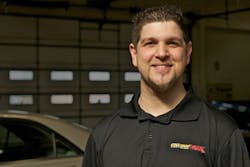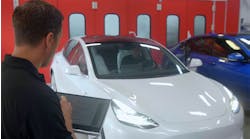Rich Tornetta was 12 years old, filing papers in his father’s body shop, when he first learned how toxic the collision repair industry could be.
“I remember smelling the paint fumes from the shop area that permeated throughout the entire building," he says. “I just took it as that’s the way it is, it’s a body shop, it’s how it’s going to be.”
What Tornetta didn’t realize then was that he’d eventually help oversee efforts to curb that “dirty body shop” stereotype while benefiting employees, customers, and the environment.
Today, at 30, Tornetta serves as the marketing manager for his family’s multi-shop operation, CollisionMax, which is based near Philadelphia. The company has been on a journey to become more eco-friendly for several years now. With 11 locations and more than 200 employees, execution of the company’s green efforts has required well-thought-out initiatives, focused leadership and committed employees.
Tornetta says the changes since his childhood—from recycling initiatives and waterborne paint to a program to help employees quit smoking—have been simple, but their impact has been huge.
“To look at the difference from then until now in terms of the attitude, the attitude is we’re a business, we’re not just a shop that fixes cars … that spreads to the people in the office, it spreads to the customers, and the way we present ourselves … the [shop] should be safe and pleasant,” he says.
CollisionMax’s methods for implementing eco-friendly strategies and uniting them as one effort, though performed on a large scale, can be applied to a business of any size. And as customers have come to expect environmental responsibility in recent years, a blueprint for green strategies should be standard in any shop.
Creating a Movement
Tornetta is an industrial designer who picked up marketing vicariously through a variety of previous work, such as taking a Taiwanese product to market in the U.S. for innovative lighting company CeeLite Technologies. His diverse background even includes developing illuminated drums for Chad Smith of the band Red Hot Chili Peppers, and assembling them on the set of "Saturday Night Live." When Tornetta joined CollisionMax full time in 2009, he set out to make the company a marketing machine with cohesive, consistent strategies.
The value of enhancing and promoting environmental stewardship, which was much hyped at the time, was not lost on him. Plus, he says, it was the right thing to do for a variety of other reasons: Employee health, energy savings, and Environmental Protection Agency compliance to name a few.
The company had a piecemeal approach to environmental efforts at the time—no strategies that were bound together and branded as a true effort to go green.
“What we were noticing was that there were already things like recycling being done, but no one really called it recycling,” Tornetta says.
Rich Brigidi, a co-founder and managing partner of CollisionMax and an early advocate for green initiatives, says the company’s transition has been gradual. As laws changed or opportunities presented themselves, the company would implement different efforts, such as a recent partnership with the local waste management company to recycle fluorescent light bulbs. Tornetta has helped the company tie those strategies together and be more proactive about new initiatives.
“We needed someone with the time and the drive to do it,” Brigidi says. “That’s the way it kind of works for any initiative and every time we do it we get better.”
Tornetta’s first order of business was to inform CollisionMax’s large staff of the company’s desire to create a more environmentally friendly, healthy environment, and seek input on potential initiatives. This was done through emails, newsletters and meetings at individual sites. Feedback from staff was almost unanimously positive and employees were eager to help.
Getting that buy-in before moving forward with any changes was crucial, Tornetta says. Making everyone aware of the company’s direction and letting them have a stake in it provided a starting point for strategy development.
—Pat Beavers, chief operating officer, CollisionMax
“When you’re in your ivory tower, the people at the shop level tend to look at you like you don’t know what you’re talking about,” Tornetta says of working as a manager. “It really does come from a philosophy of [the employees]; they are the experts, and the ones who really have the ideas.”
Pat Beavers, managing partner and chief operating officer for CollisionMax, says getting vendors on board was also important, because it prompted partners to think about how they could get involved—through recycling bumper cores, for example—for mutual benefit.
“The key is to integrate the business partners, trading partners and the people who make it happen on a daily basis,” Beavers says. “Sometimes these guys start to drive it themselves and it winds up becoming its own movement. It grows on its own.”
Implementing Ideas
After setting out on its green quest, CollisionMax focused on several key initiatives, each of which went through the same process of being discussed with employees, developed by managers, and launched with a clear timeline and expectations. The cost of each initiative was weighed with the benefits, but return on investment has not been a primary factor.
“The green steps that our company has taken thus far are things that we think a company of our size should have been doing at that particular point in time,” Brigidi says.
When new strategies were launched, staff responsibilities were added to employee handbooks and regional managers were put in charge of maintaining those new procedures. The initiatives were then marketed in a variety of places, including the shop’s website and social media pages, something that hadn’t been done before.
The most notable changes:
Waterborne conversion. CollisionMax converted seven of its 11 facilities to waterborne paint in less than a year, an intense and expensive undertaking done in anticipation of state mandates, and to improve air quality.
“We saw waterborne paints were becoming important in the industry and we wanted to keep the guys in the shops safe and increase the quality of air in the offices,” Tornetta says.
CollisionMax plans to complete the conversion by the end of 2012 at a total cost of $70,000, or roughly $6,300 per facility.
Standardized Recycling. When Tornetta joined CollisionMax, some departments recycled, some did not, and some shops recycled more than others.
“When I came, it was a shock to see what wasn’t being done,” Tornetta says. “I pushed through what a lot of other people got tired of trying to push through.”
The company recently hired a local recycling company to pick up its small paper, plastic and aluminum waste, and equipped each department in every shop with blue recycling bins wearing the CollisionMax logo.
“These are being heavily embraced and I can’t get them out fast enough,” Tornetta says.
Though the company hired a new service to do the recycling, it is still coming out ahead financially because it was able to cut back on trash pickup.
CollisionMax also developed new standard operating procedures for scrap recycling and partnered with a vendor that shreds and recycles bumper cores. As an incentive to recycle scrap aluminum, shop-level employees can turn it in for cash that is put toward company events.
Anti-Smoking Campaign. To address complaints from customers about smoke wafting into offices, and to improve the image and health of the company, CollisionMax became 100 percent smoke free within all of its shops in 2010. The company created designated smoking areas away from building entrances and started connecting employees interested in quitting with local support services. The effort cost the company virtually nothing, but the benefits were immediate.
Still Building
CollisionMax now refers to all of its eco efforts as pieces of its larger green movement. They are no longer inconsistent efforts that lack employee buy-in and public awareness. And the company is starting to look into some bigger efforts.
Brigidi says CollisionMax is considering adding solar arrays to its shops. The company received an estimate and has begun the discussion with staff, but it’s not ready to make the leap just yet.
“I just think we need some more time before we’re ready to commit to it,” he says.
Tornetta says he’s received a tremendous amount of positive feedback on the company’s green initiatives from customers, so he’s planning to roll out a bolder marketing campaign later this year that will further emphasize the company’s efforts.
“I want to be able to say that CollisionMax is eco-friendly,” Tornetta says. “This is something that I didn’t realize was going to get as much attention as it has.”



